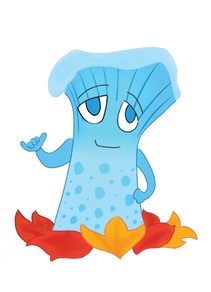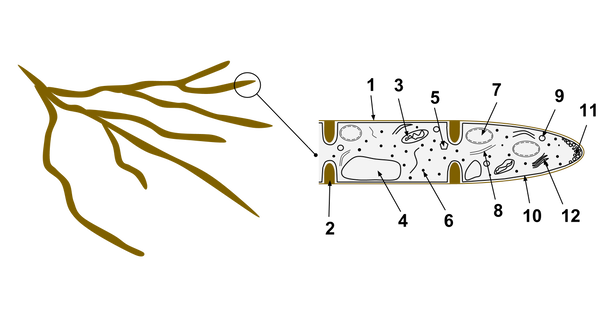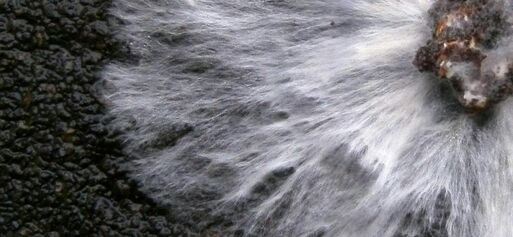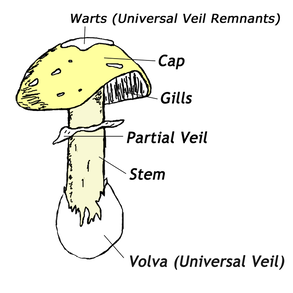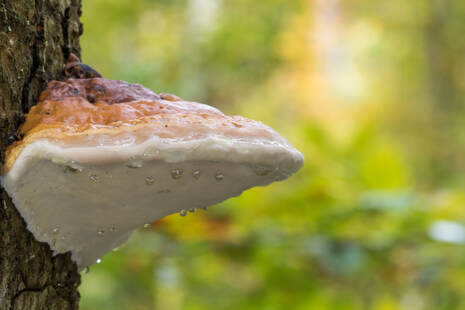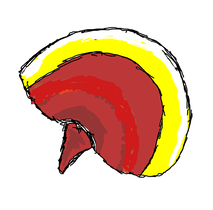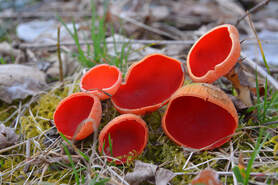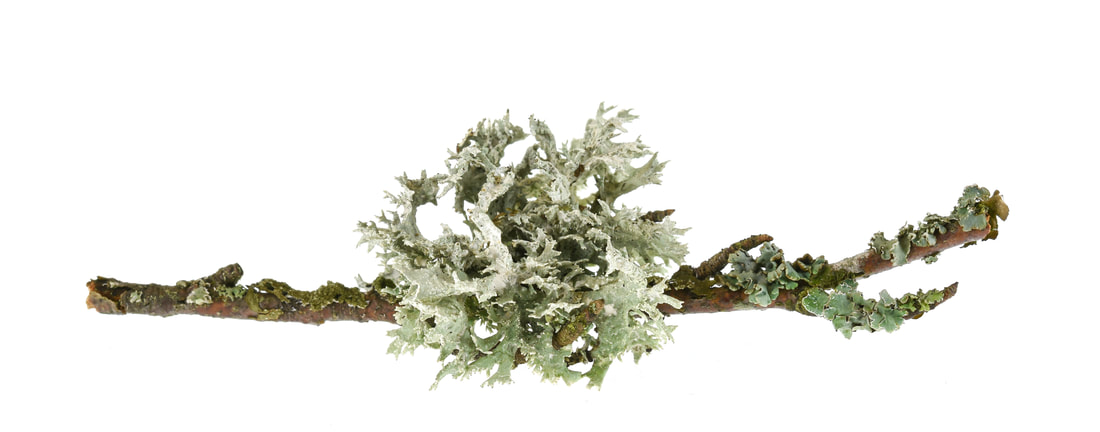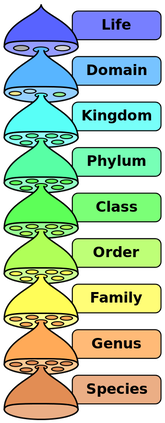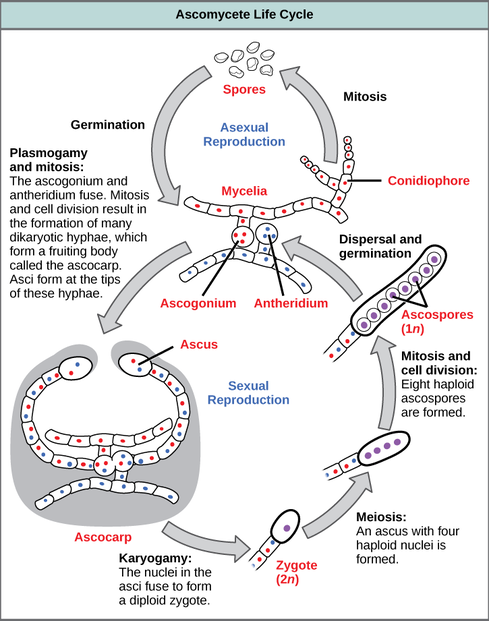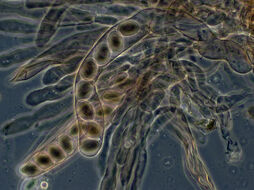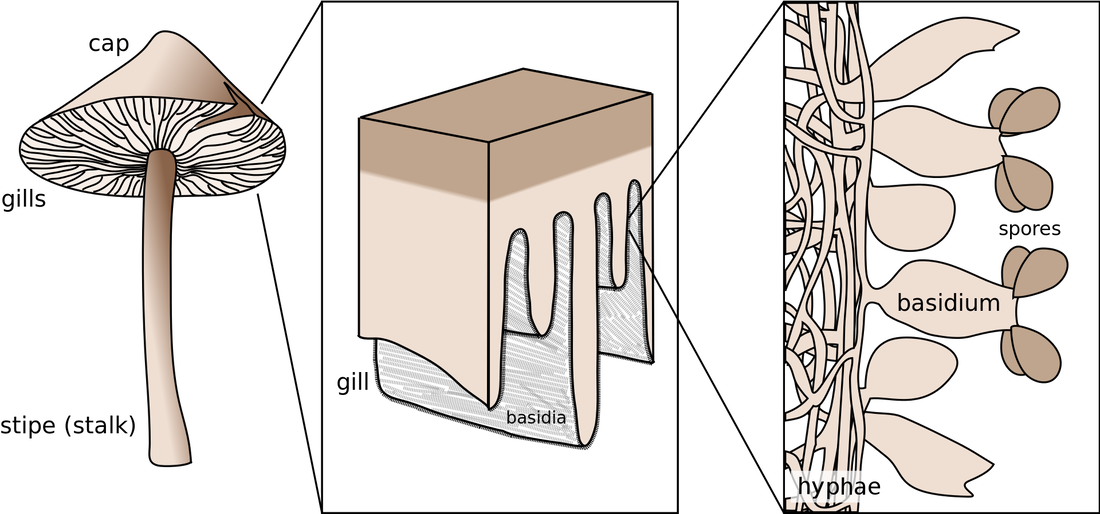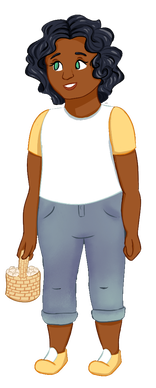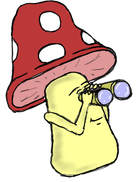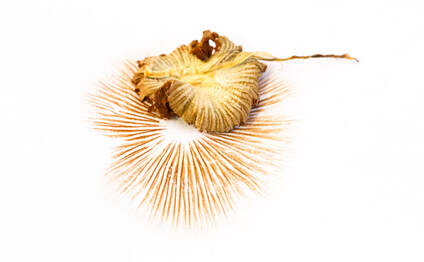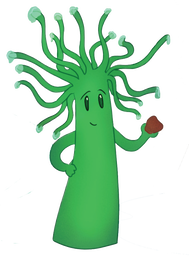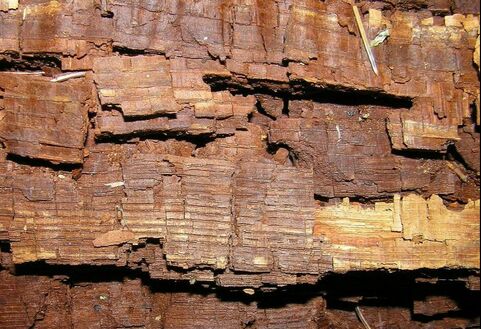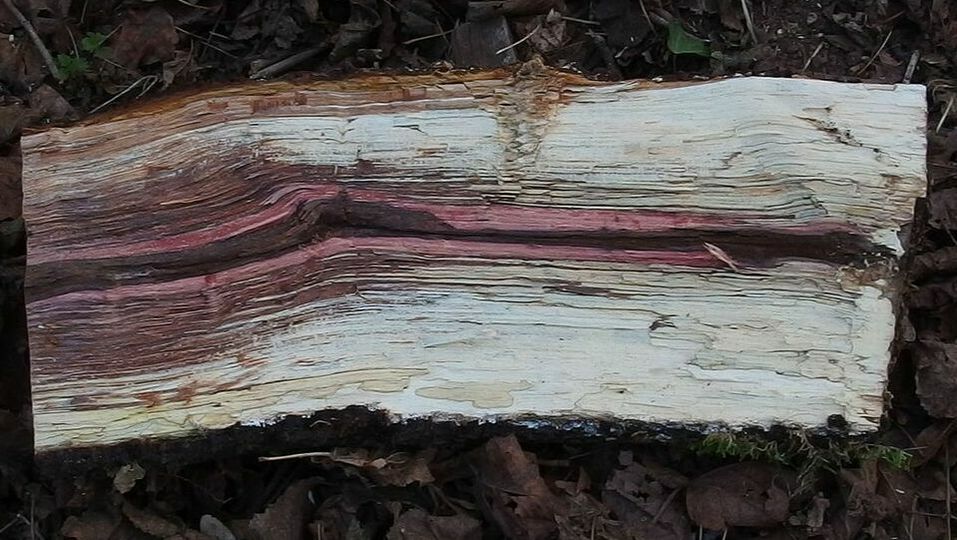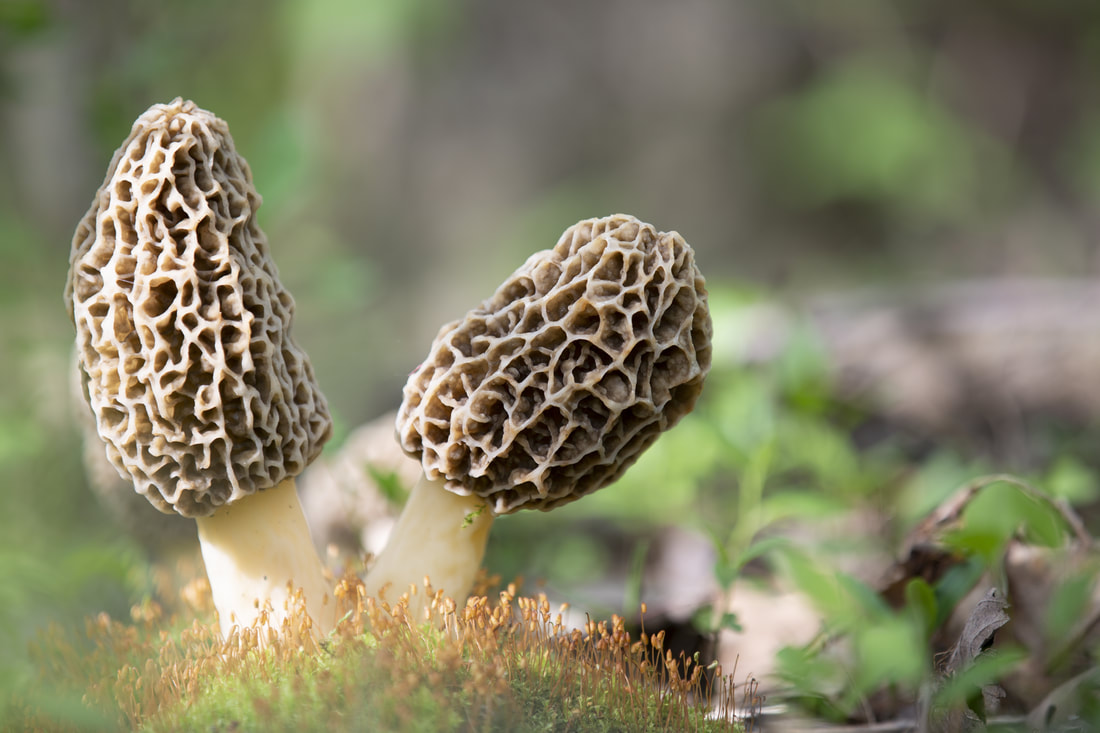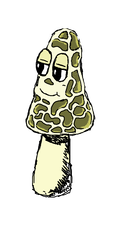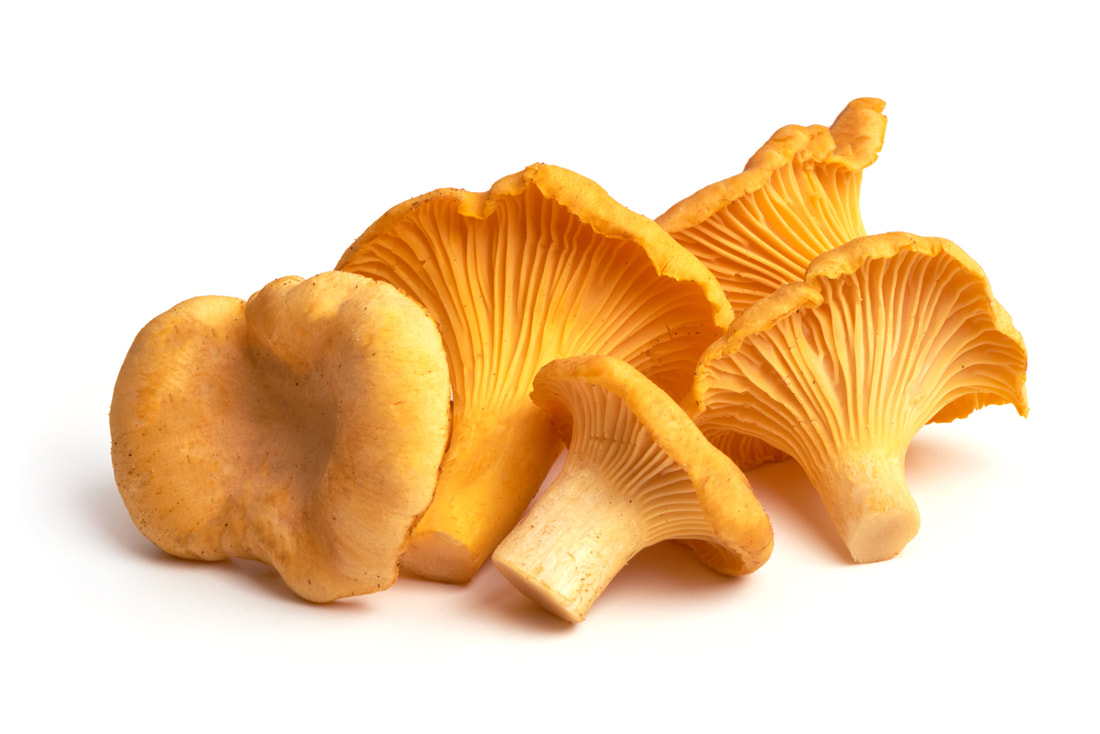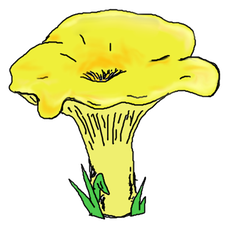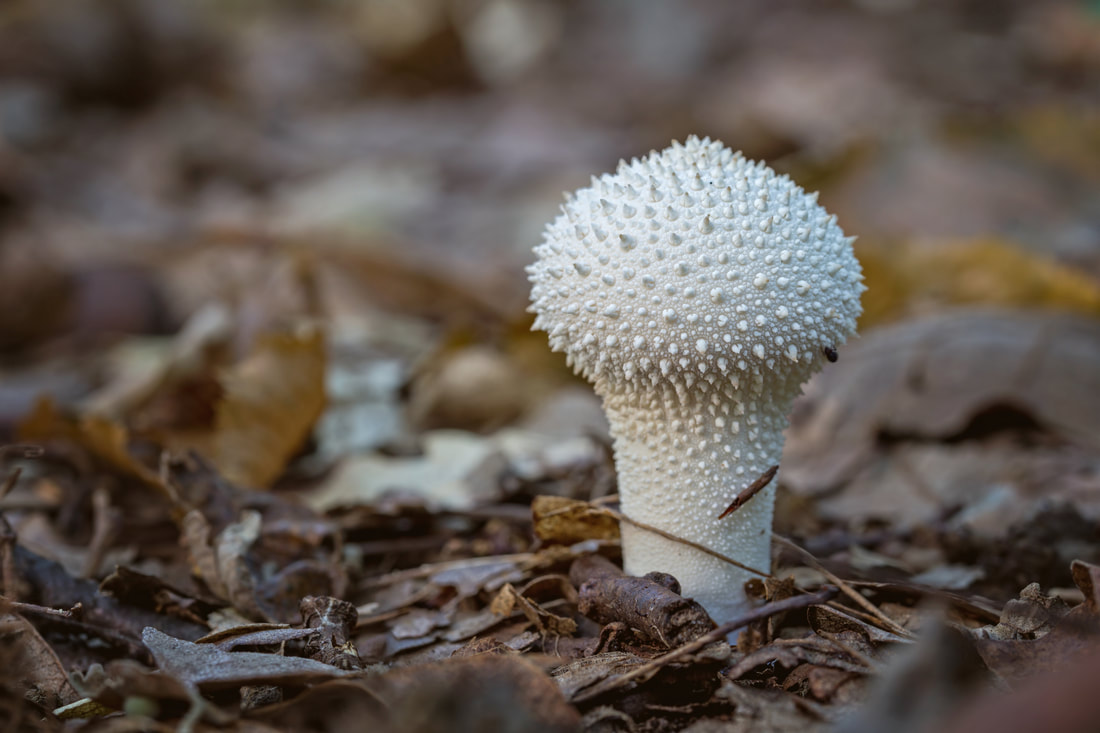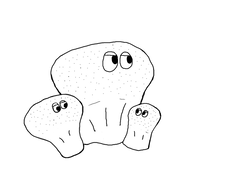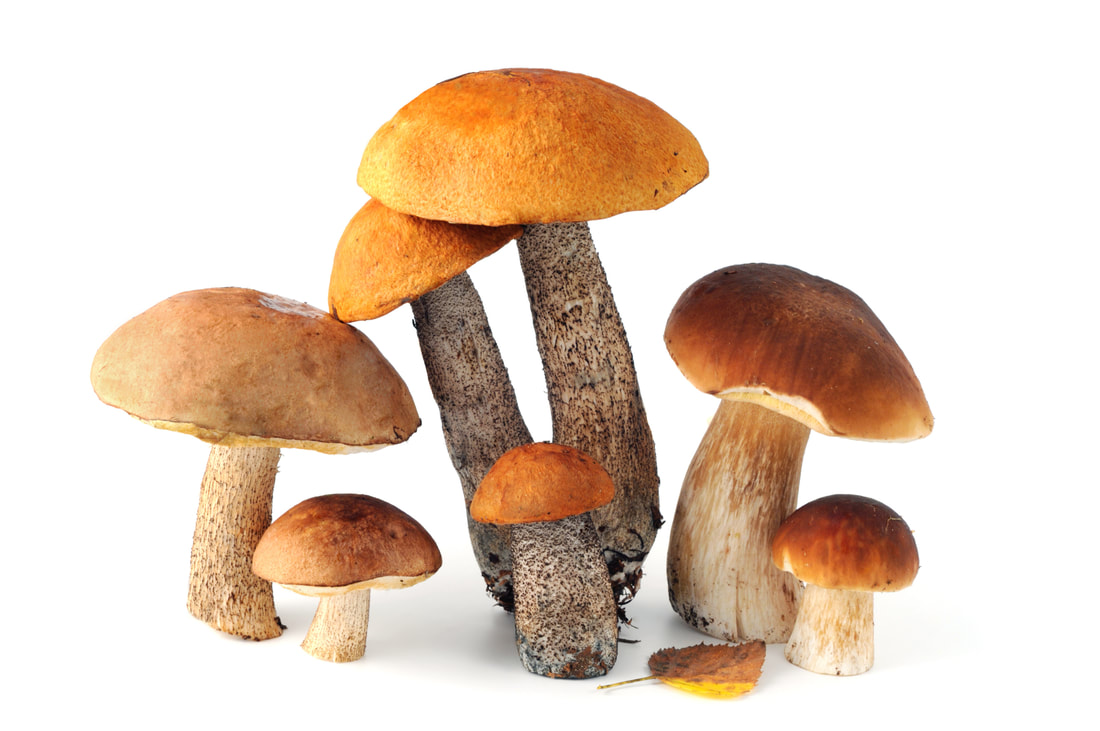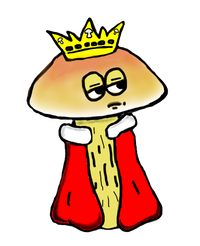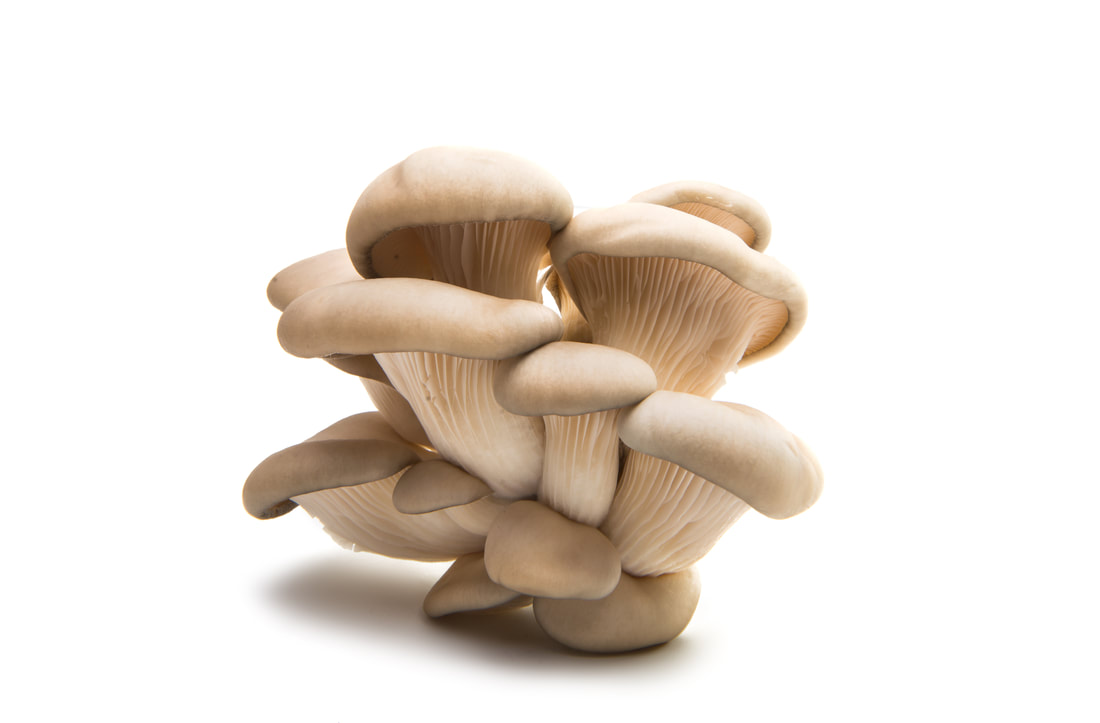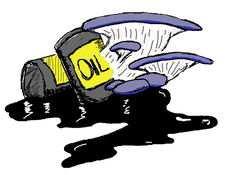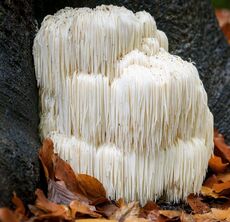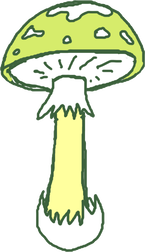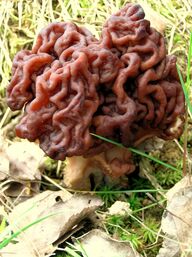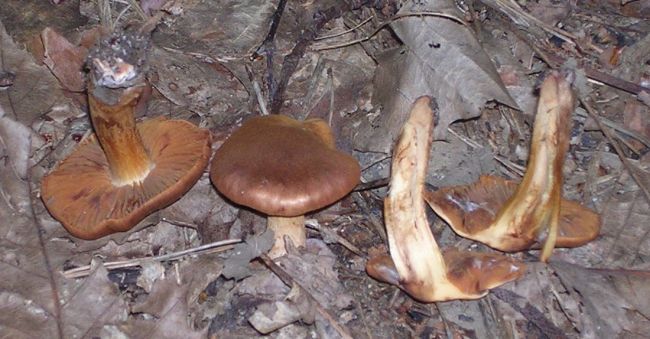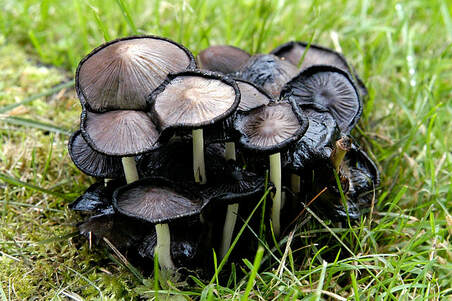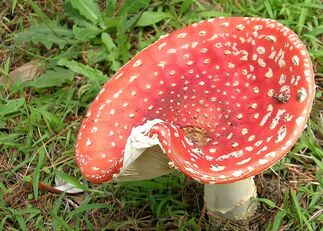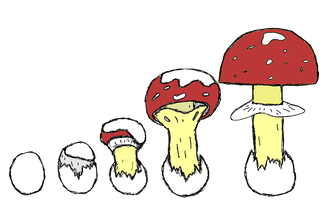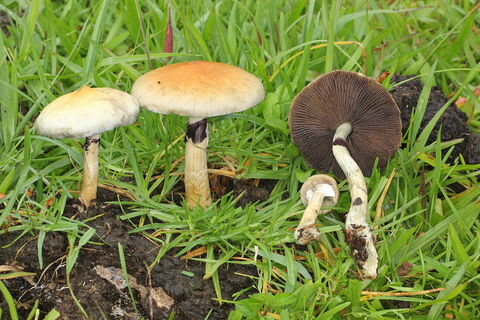|
Ready to learn about fungi?
Click a chapter below to explore an area of study to jump start your mycological education! Chapter 1: Meet the Fungus Among Us Chapter 2: Reproduction Chapter 3: Mushroom Hunting 101 Chapter 4: Mycorrhizal Fungi Chapter 5: Saprophytic (Decomposing) Fungi Chapter 6: Parasitic Fungi Chapter 7: Common Edible Mushrooms Chapter 8: Mushroom Poisons and Other Things to Consider Glossary |
Anchor Element
Copy for linking on the same page:
https://www.toadstoolstreasures.com/mycology-101?data-scroll-to-anchor=one
Copy for linking from an external page:
https://www.toadstoolstreasures.com/mycology-101?data-anchor-link=one
Chapter One: Meet the Fungus Among Us
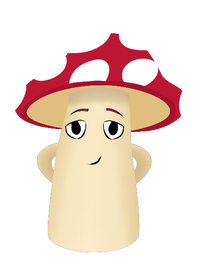
What are Fungi?
Most of the time, when people think about fungi, they think "mushrooms". But fungi are much more than mushrooms! To put this into perspective, check out this quote from legendary popular mycologist, Paul Stamets:
"Fungi outnumber plants at a ratio of at least 6 to 1. About 10 percent of fungi are what we call mushrooms, and only about 10 percent of the mushroom species have been identified, meaning that our taxonomic knowledge of mushrooms is exceeded by our ignorance by at least one order of magnitude."
- Stamets, Paul Mycelium Running: How Mushrooms Can Help Save The World. (10-11)
Fungi are a hugely megadiverse kingdom within the domain of life called Eukarya! It is estimated that there exists approximately 1.5 million different species of fungi!
Fungi are:
- Eukaryotic, which means that their cells contain a nucleus within a membrane which houses DNA. Pretty much all of life except bacteria are eukaryotic. So even though sometimes people often think of fungi and bacteria as being similar - fungi are actually quite different and are more similar to plants and animals than bacteria.
- Heterotrophic, which means they cannot produce their own energy, and so rely on outside sources of energy. This opposed to Autotrophs, which can use things like light and carbon dioxide to produce energy. Examples of autotrophs are plants and algae.
Do you know what else is eukaryotic and heterotrophic?
YOU!
Humans are eukaryotic and heterotrophic, unlike plants which are eukaryotic and autotrophic. So even though fungi commonly get compared to plants, or even referred to as plants, really it makes more sense to compare them to animals!
Most of the time, when people think about fungi, they think "mushrooms". But fungi are much more than mushrooms! To put this into perspective, check out this quote from legendary popular mycologist, Paul Stamets:
"Fungi outnumber plants at a ratio of at least 6 to 1. About 10 percent of fungi are what we call mushrooms, and only about 10 percent of the mushroom species have been identified, meaning that our taxonomic knowledge of mushrooms is exceeded by our ignorance by at least one order of magnitude."
- Stamets, Paul Mycelium Running: How Mushrooms Can Help Save The World. (10-11)
Fungi are a hugely megadiverse kingdom within the domain of life called Eukarya! It is estimated that there exists approximately 1.5 million different species of fungi!
Fungi are:
- Eukaryotic, which means that their cells contain a nucleus within a membrane which houses DNA. Pretty much all of life except bacteria are eukaryotic. So even though sometimes people often think of fungi and bacteria as being similar - fungi are actually quite different and are more similar to plants and animals than bacteria.
- Heterotrophic, which means they cannot produce their own energy, and so rely on outside sources of energy. This opposed to Autotrophs, which can use things like light and carbon dioxide to produce energy. Examples of autotrophs are plants and algae.
Do you know what else is eukaryotic and heterotrophic?
YOU!
Humans are eukaryotic and heterotrophic, unlike plants which are eukaryotic and autotrophic. So even though fungi commonly get compared to plants, or even referred to as plants, really it makes more sense to compare them to animals!
The body of a fungus is made of strands of cells called hyphae, which weave into a network of cells which is called a mycelium!
The body of a fungus is made of strands of cells called hyphae, which weave into a network of cells which is called a mycelium!
|
There are many different types of fungi.
For instance, there is the classic gilled mushroom that most people imagine when they think of fungi. These would include the capped mushrooms you find on your lawn or many of the mushrooms you might eat. The mushroom itself is a reproductive structure produced from the hyphae. |
|
There are also fungi that are called "Polypores."
("Poly-" = "many", so "polypore" = "many pores") Polypores are typically the mushrooms that are often thought of as "shelf fungi". These are usually found on decaying wood or trees and get their name from the series of small pores on the underside of the cap which release spores. Sometimes these holes are so small you cannot seem them with the naked eye! |
Anchor Element
Copy for linking on the same page:
https://www.toadstoolstreasures.com/mycology-101?data-scroll-to-anchor=two
Copy for linking from an external page:
https://www.toadstoolstreasures.com/mycology-101?data-anchor-link=two
Chapter two: Fungal Reproduction

How Do Fungi Make More Of Themselves??
Fungi produce spores, which are often spherical (with a lot of variation!), that are germinated in order to begin the life cycle. A spore is kind of like an egg or a seed...the potential for future life rests in a fungus' spores!
When these spores germinate, or begin developing, they start making hyphal cells, which make up the body of the fungus. A collection of hyphae (plural for hypha) form mycelia.
So, how do you tell if a fungus is a boy or a girl?
The simple answer is that there are no male or female fungi! Instead, there is the "+" mating type and the "-" mating type. When the two cell types meet they come together to form one body which then begins working on forming a sporocarp! The sporocarp is the structure that houses the spores!
Fungi produce spores, which are often spherical (with a lot of variation!), that are germinated in order to begin the life cycle. A spore is kind of like an egg or a seed...the potential for future life rests in a fungus' spores!
When these spores germinate, or begin developing, they start making hyphal cells, which make up the body of the fungus. A collection of hyphae (plural for hypha) form mycelia.
So, how do you tell if a fungus is a boy or a girl?
The simple answer is that there are no male or female fungi! Instead, there is the "+" mating type and the "-" mating type. When the two cell types meet they come together to form one body which then begins working on forming a sporocarp! The sporocarp is the structure that houses the spores!
|
There are eight proposed phyla of fungi, however we are going to focus on the two major phyla of fungi: The Ascomycota and the Basidiomycota!
Each of these particular phyla of fungi get their name from the name of the structure which delivers spores into the environment! Ascomycetes, if they reproduce sexually, have an ascus, while Basidiomycetes have a basidium! It's that simple. Now let's look at the differences of these two fungal groups and we'll figure out the differences between these two sporocarps! Ascomycetes are typically thought of as the "cup fungi" or "sac fungi." Examples of Ascomycetes are truffles, morels, elvin saddles, cup mushrooms and molds like penicillium which grows on citrus peels and provides the antibiotic Penicillin! |
|
When an Ascomycete reproduces sexually, the spores are produced in a specialized reproductive cell called an ascus. These asci then form an ascocarp, often in a cup shape!
Note that the Ascocarp only forms during sexual reproduction. In asexual reproduction, only the "+" mating type will form a spore producing structure called a Conidium which can disperse and form a genetically similar organism! So, remember: Sexual Reproduction = Ascus Asexual Reproduction = Conidium |
|
Basidiomycetes are typically thought of as the "club fungi," because the basidium often looks like a club.
Note the differences between an ascus and a basidium! Basidia can appear several different ways, but this should give you an indication of a key difference: in an ascus, the spores are lined up in a sort of sheath and forcibly discharged, but in a basidium the spores usually rest at the top of a club like structure where they are then dispersed. |
Anchor Element
Copy for linking on the same page:
https://www.toadstoolstreasures.com/mycology-101?data-scroll-to-anchor=three
Copy for linking from an external page:
https://www.toadstoolstreasures.com/mycology-101?data-anchor-link=three
Chapter Three: Introduction to Mushroom Hunting
Now, let's get into the basics of mushroom hunting! Then I will introduce you to some easily distinguishable genera of mushrooms.
But first, a disclaimer:
NEVER CONSUME A MUSHROOM THAT YOU CANNOT CONFIDENTLY IDENTIFY. PLEASE CONSULT WITH A PROFESSIONAL BEFORE CONSUMING WILD FORAGED MUSHROOMS. THERE ARE DANGEROUS LOOK-A-LIKES AND AN ERROR COULD BE FATAL! THIS INFORMATION IS STRICTLY FOR EDUCATIONAL PURPOSES AND SHOULD NOT BE USED AS SUFFICIENT INFORMATION TO CONSUME ANY FORAGED MUSHROOMS. THE READER IS RESPONSIBLE FOR HOWEVER THEY USE THIS INFORMATION.
But first, a disclaimer:
NEVER CONSUME A MUSHROOM THAT YOU CANNOT CONFIDENTLY IDENTIFY. PLEASE CONSULT WITH A PROFESSIONAL BEFORE CONSUMING WILD FORAGED MUSHROOMS. THERE ARE DANGEROUS LOOK-A-LIKES AND AN ERROR COULD BE FATAL! THIS INFORMATION IS STRICTLY FOR EDUCATIONAL PURPOSES AND SHOULD NOT BE USED AS SUFFICIENT INFORMATION TO CONSUME ANY FORAGED MUSHROOMS. THE READER IS RESPONSIBLE FOR HOWEVER THEY USE THIS INFORMATION.
|
What Gear Do I Need for Mushroom Hunting?
1) Knife - a simple pocket knife will do for beginners. Use with caution. Face the blade away from your body when cutting. 2) Container(s) - such as a woven basket, paper bags, or wax paper. Newspaper can work in a pinch. Never use plastic bags or air tight containers! The mushrooms will rot very quickly if you do! If you are serious about mushrooming, I highly recommend you find a good woven basket to take with you in the field. That way you won't be wasting resources like paper bags or wax paper. 3) Field guide - I recommend David Arora's Mushrooms Demystified. If you want something you can take with you in the field there are an assortment of good pocket guides out there like Arora's All That The Rain Promises, And More or one of the classic Audubon, Timber Press, or Peterson field guides. 4) A magnifier - a magnifier is handy so that you can get a close look at gill structure and other fine details which become critical in accurately identifying some species.This is really all you need. The magnifier is optional for beginners. Optional Gear: Another tool you could bring with you in the field is a good pair of binoculars. If the 'shrooms aren't out maybe your mushrooming trip could turn into a bird watching trip! A compass could also be useful to make sure you can find your way home! |
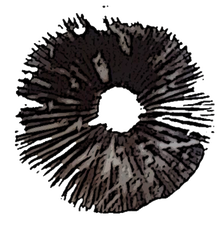
Taking Spore Prints
In many cases, a defining characteristic of a mushroom will be spore color. Sometimes you can look at the gill color of a mushroom, or the color the partial veil, to determine the color of the spores, but sometimes this is not enough. In order to properly check the spore color of a mushroom, it is important to take a "spore print."
Luckily, spore prints are easy to obtain! Here is how to do it:
1) You will need a white piece of paper and a black piece of paper. (The black paper is in case the spores are a light color that will not show up well on a white background.)
2) Cut the cap off of the stem of the mushroom.
3) Place a cap on each of the pieces of paper.
4) Leave for a few hours. The longer you can wait, the better the result.
5) Remove the caps and check for a spore print!
In many cases, a defining characteristic of a mushroom will be spore color. Sometimes you can look at the gill color of a mushroom, or the color the partial veil, to determine the color of the spores, but sometimes this is not enough. In order to properly check the spore color of a mushroom, it is important to take a "spore print."
Luckily, spore prints are easy to obtain! Here is how to do it:
1) You will need a white piece of paper and a black piece of paper. (The black paper is in case the spores are a light color that will not show up well on a white background.)
2) Cut the cap off of the stem of the mushroom.
3) Place a cap on each of the pieces of paper.
4) Leave for a few hours. The longer you can wait, the better the result.
5) Remove the caps and check for a spore print!

Things to Keep in Mind
There are a few things to keep in mind while mushrooming.
First of all, respect any landowners that might be involved in your quest! Do not trespass on private land. Instead, ask for permission before hiking onto someone's private land to hunt for mushrooms. You will likely be surprised at how often property owners will grant you permission. Always obtain any necessary mushroom picking permits if hunting on public lands like national parks, state parks, etc.
Take it easy! Don't harvest every mushroom you see, however tempting it might be. Always leave some for the bugs and critters that also enjoy our fungi friends! I like to give the caps of mushrooms a tap before I harvest them, just to help expel some spores before I carry it away from the area.
Be prepared to encounter maggots and other bugs (lots of them, in some cases). I have harvested many a mushroom just to get it back home and see tons of larvae wiggling around. Don't worry, just relocate them and they will not bother you again.
Don't be afraid to touch a mushroom. You will not die from touching a mushroom. There is a massive case of mycophobia out there, but most of it stems from ignorance, as most fear does. Even the most deadly mushrooms can be handled safely. The key is to avoid eating them! If you can do this one simple thing, then you can enjoy examining most any mushroom. Additionally, always practice proper hygiene and clean your hands before touching your face.
There are a few things to keep in mind while mushrooming.
First of all, respect any landowners that might be involved in your quest! Do not trespass on private land. Instead, ask for permission before hiking onto someone's private land to hunt for mushrooms. You will likely be surprised at how often property owners will grant you permission. Always obtain any necessary mushroom picking permits if hunting on public lands like national parks, state parks, etc.
Take it easy! Don't harvest every mushroom you see, however tempting it might be. Always leave some for the bugs and critters that also enjoy our fungi friends! I like to give the caps of mushrooms a tap before I harvest them, just to help expel some spores before I carry it away from the area.
Be prepared to encounter maggots and other bugs (lots of them, in some cases). I have harvested many a mushroom just to get it back home and see tons of larvae wiggling around. Don't worry, just relocate them and they will not bother you again.
Don't be afraid to touch a mushroom. You will not die from touching a mushroom. There is a massive case of mycophobia out there, but most of it stems from ignorance, as most fear does. Even the most deadly mushrooms can be handled safely. The key is to avoid eating them! If you can do this one simple thing, then you can enjoy examining most any mushroom. Additionally, always practice proper hygiene and clean your hands before touching your face.
Anchor Element
Copy for linking on the same page:
https://www.toadstoolstreasures.com/mycology-101?data-scroll-to-anchor=four
Copy for linking from an external page:
https://www.toadstoolstreasures.com/mycology-101?data-anchor-link=four
Chapter Four: Mycorrhizal Fungi
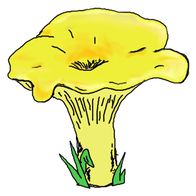
Fungi make their way in the world through a variety of strategies. Some fungi live in the soil and gather nutrition by sharing nutrients and water with the roots of nearby plants! These are called mycorrhizal fungi!
Did you know that nearly 90% of plants form associations with mycorrhizal fungi!
While often times the associations between plants and mycorrhizal fungi are mutualistic and beneficial, these relationships actually fall on a large spectrum that ranges from symbiotic (fungus wins - plant wins) to parasitic (fungus wins - plant loses).
Mycorrhizal fungi gain nutrition by sharing phosphorous or other nutrients with the plant while gaining carbohydrates from the plant. Essentially the fungus sort of piggybacks on the plant's photosynthesis abilities.
There are two primary types of mycorrhizal fungi (this is a bit of an over-simplification, but for now it will do):
Arbuscular Mycorrhizal (AM) and Ectomycorrhizal (EM) fungi.
The difference is simple!
AMs penetrate plant cell walls to exchange nutrients while EMs do not penetrate cell walls. This is why EMs are "Ecto-" (outside) "-mycorrhizal." EMs form a sheath of hyphal cells around the root and then penetrate the root and surround the cells within the root. AMs penetrate the root at a "site of infection" and then make their way into the plant cells themselves.
AMs are all members of the phylum Glomeromycota, which means they produce a substance called Glomalin! Glomalin is thought of as a "soil glue" because it binds nutrients in the soil together. When glomalin breaks down it fertilizes the land with the nutrients that it was holding together!
Mycorrhizal fungi are particularly interesting because they can, at times, connect to the roots of other plants and end up sharing resources among plant populations and the fungi connected to them! These are commonly called Common Mycorrhizal Networks (CMNs) and are becoming a big subject of study in modern ecology and microbiology! These networks even seem to be able to transport signals between plants to provide information about environmental stresses or changes that the plants might need to prepare for! (Check out this article!)
Mycorrhizal fungi can even help protect plants from things like heavy metals, disease, and even drought!
Did you know that nearly 90% of plants form associations with mycorrhizal fungi!
While often times the associations between plants and mycorrhizal fungi are mutualistic and beneficial, these relationships actually fall on a large spectrum that ranges from symbiotic (fungus wins - plant wins) to parasitic (fungus wins - plant loses).
Mycorrhizal fungi gain nutrition by sharing phosphorous or other nutrients with the plant while gaining carbohydrates from the plant. Essentially the fungus sort of piggybacks on the plant's photosynthesis abilities.
There are two primary types of mycorrhizal fungi (this is a bit of an over-simplification, but for now it will do):
Arbuscular Mycorrhizal (AM) and Ectomycorrhizal (EM) fungi.
The difference is simple!
AMs penetrate plant cell walls to exchange nutrients while EMs do not penetrate cell walls. This is why EMs are "Ecto-" (outside) "-mycorrhizal." EMs form a sheath of hyphal cells around the root and then penetrate the root and surround the cells within the root. AMs penetrate the root at a "site of infection" and then make their way into the plant cells themselves.
AMs are all members of the phylum Glomeromycota, which means they produce a substance called Glomalin! Glomalin is thought of as a "soil glue" because it binds nutrients in the soil together. When glomalin breaks down it fertilizes the land with the nutrients that it was holding together!
Mycorrhizal fungi are particularly interesting because they can, at times, connect to the roots of other plants and end up sharing resources among plant populations and the fungi connected to them! These are commonly called Common Mycorrhizal Networks (CMNs) and are becoming a big subject of study in modern ecology and microbiology! These networks even seem to be able to transport signals between plants to provide information about environmental stresses or changes that the plants might need to prepare for! (Check out this article!)
Mycorrhizal fungi can even help protect plants from things like heavy metals, disease, and even drought!
Anchor Element
Copy for linking on the same page:
https://www.toadstoolstreasures.com/mycology-101?data-scroll-to-anchor=five
Copy for linking from an external page:
https://www.toadstoolstreasures.com/mycology-101?data-anchor-link=five
Chapter Five: Saprophytic Fungi
Another way that many fungi survive is by breaking down organic matter! These fungi are called saprophytic fungi. These fungi can break down things because they can secrete enzymes which can break apart various chemical structures! Not all fungi can break down the same chemicals, but we will get to that in a moment!
So, What are these fungi breaking down?
What is the typical "waste", or dead stuff, that we would find in a natural environment, like a forest? There would mostly be leaves and wood, right?
And what makes up leaves and wood? Mostly it's cellulose, hemicellulose, and lignin, with the exception of some simple sugars, amino acids, etc. It is important to understand the difference between these chemicals in order to understand the key differences among common saprophytic fungi.
Cellulose consists of a series of glucose molecules bound together. It makes up half of all plant tissue! The way that fungi deal with this is they break the complex chain of glucose into shorter chains, which are then broken down into single glucose units, which are then absorbed!
In wood, it is the Brown Rot Fungi that break down cellulose, but they cannot break down lignin. When fungi only break down cellulose, but leave behind the more complex components of wood, like lignin, it creates a brown, blocky appearance in the wood (hence the name "brown rot").
Lignin is a complex chemical that is abundant in wood. It contains very strong chemical bonds which make it hard to break down. There are some fungi that can chip away at lignin but only specialized White Rot Fungi can break down the entire structure of lignin, often leaving behind white strands of cellulose (hence the name "white rot"). These white rot fungi that have enzymes that can break these strong bonds can also break down cellulose and other simpler chemical structures.
It is usually Ascomycetes fungi (along with bacteria) that are breaking down leaves. But it's the Brown Rot and White Rot Basidiomycetes that break down most of the wood!
So, What are these fungi breaking down?
What is the typical "waste", or dead stuff, that we would find in a natural environment, like a forest? There would mostly be leaves and wood, right?
And what makes up leaves and wood? Mostly it's cellulose, hemicellulose, and lignin, with the exception of some simple sugars, amino acids, etc. It is important to understand the difference between these chemicals in order to understand the key differences among common saprophytic fungi.
Cellulose consists of a series of glucose molecules bound together. It makes up half of all plant tissue! The way that fungi deal with this is they break the complex chain of glucose into shorter chains, which are then broken down into single glucose units, which are then absorbed!
In wood, it is the Brown Rot Fungi that break down cellulose, but they cannot break down lignin. When fungi only break down cellulose, but leave behind the more complex components of wood, like lignin, it creates a brown, blocky appearance in the wood (hence the name "brown rot").
Lignin is a complex chemical that is abundant in wood. It contains very strong chemical bonds which make it hard to break down. There are some fungi that can chip away at lignin but only specialized White Rot Fungi can break down the entire structure of lignin, often leaving behind white strands of cellulose (hence the name "white rot"). These white rot fungi that have enzymes that can break these strong bonds can also break down cellulose and other simpler chemical structures.
It is usually Ascomycetes fungi (along with bacteria) that are breaking down leaves. But it's the Brown Rot and White Rot Basidiomycetes that break down most of the wood!
Anchor Element
Copy for linking on the same page:
https://www.toadstoolstreasures.com/mycology-101?data-scroll-to-anchor=six
Copy for linking from an external page:
https://www.toadstoolstreasures.com/mycology-101?data-anchor-link=six
Chapter Six: Parasitic Fungi
Another way that fungi live is by feeding on a living host. This is called parasitism. There are fungi that parasitize animals, plants, insects, microorganisms, and even other fungi!
By now you should be getting an idea of the megadiversity of fungi! They can collectively break down, absorb, or feed on just about anything!
There are fungi that feed on living fungi...
fungi that feed on living insects...
fungi that feed on living grasses and herbs...
and fungi that feed on living trees...
and fungi that feed on mammals and other animals!
Explore the gallery to learn about various types of parasitic fungi!
By now you should be getting an idea of the megadiversity of fungi! They can collectively break down, absorb, or feed on just about anything!
There are fungi that feed on living fungi...
fungi that feed on living insects...
fungi that feed on living grasses and herbs...
and fungi that feed on living trees...
and fungi that feed on mammals and other animals!
Explore the gallery to learn about various types of parasitic fungi!
|
|
Anchor Element
Copy for linking on the same page:
https://www.toadstoolstreasures.com/mycology-101?data-scroll-to-anchor=seven
Copy for linking from an external page:
https://www.toadstoolstreasures.com/mycology-101?data-anchor-link=seven
Chapter Seven: Common Edible Mushrooms
|
Morels
These guys have a very distinct morphology! They are ascomycetes and are basically a bunch of little cups on a stalk. The inside of a morel is hollow and if you chop up the cap you will end up with a bunch of rings. Because of their distinct morphology they are easy to identify. Do not confuse it with the False Morel which is typically heavier, darker in color, and misshapen. The Flase Morel is also known as Gyromitra and contains monomethylhydrazine, also known as rocket fuel! |
Chanterelles
These mushrooms also have a pretty distinct morphology. They are usually yellow to orange (although there is variation) and are trumpet shaped. They have rudimentary gills which often appear more like veins running slightly decurrent down the stem. Once you see one chanterelle, start to look around because there are almost always a lot more hiding! A dangerous look-a-like is the False Chanterelle which is typically smaller than a true chanterelle and have true gills. |
|
Puffballs
All young puffballs are edible! Just cut one in half to determine age. If it is white and spongy inside, then it is good to eat! Cut into slices, bread, and fry for some tasty puffball fritters! DANGER: Young Amanita mushrooms can be mistaken for puffballs. Always carefully examine the cross section of a suspected puffball and make sure there are no signs of an immature cap, gills, and stem. |
Boletes
Many boletes are edible and choice, but you really will want a field guide to learn the different varieties. Some general local wisdom is to avoid red pored boletes, although some claim that certain red pored boletes are edible. This is why, in the end you have to use a guide and identify to species. |
|
Oyster Mushrooms
These white-rot fungi grow on decaying logs and fallen trees, as well as on wood chips and debris. These are gilled mushrooms that lack a true stem. The caps can be a variety of colors such as white, pink, or even blue, but the spores are always white! Oyster mushrooms can be used for mycoremediation as they can filter water and break down oils! Oyster mushrooms are great cooked in soy sauce and lightly seasoned. |
Lion's Mane (and related)
This toothed fungus is pretty easy to identify. It grows on decaying wood. I find that in the Southeastern United States, they tend to show themselves when fall approaches winter and when winter approaches spring, but in general it is thought that they are a late summer/fall mushroom. There are a few look-a-likes for this mushroom but they are edible, so no worries! The Lion's Mane mushroom serves as a good seafood substitute! |
Anchor Element
Copy for linking on the same page:
https://www.toadstoolstreasures.com/mycology-101?data-scroll-to-anchor=eight
Copy for linking from an external page:
https://www.toadstoolstreasures.com/mycology-101?data-anchor-link=eight
Chapter Eight: Mushroom POisons and other things to consider
Now let's talk about the fungi that you want to avoid eating! These fungi are at the core of mycophobia, or the fear of fungi.
Disclaimer Reminder: Never eat a mushroom that you cannot have properly identified. This website is no substitution for experience and a field guide. None of this information is medical or health advice. This information is for educational purposes only.
You most likely will not get hurt examining a mushroom. In order to get sick, you must actually consume the mushroom. And even then, what happens next depends on how much of the mushroom you eat and what your body's chemistry is like.
It's important to remember that most mushrooms are not poisonous. Many are not very tasty, but most will not hurt you. However, here are some of the ones that will! Luckily they are pretty easy to identify so you can stay safe while mushroom hunting!
Disclaimer Reminder: Never eat a mushroom that you cannot have properly identified. This website is no substitution for experience and a field guide. None of this information is medical or health advice. This information is for educational purposes only.
You most likely will not get hurt examining a mushroom. In order to get sick, you must actually consume the mushroom. And even then, what happens next depends on how much of the mushroom you eat and what your body's chemistry is like.
It's important to remember that most mushrooms are not poisonous. Many are not very tasty, but most will not hurt you. However, here are some of the ones that will! Luckily they are pretty easy to identify so you can stay safe while mushroom hunting!
|
Amanitins
Members of the genera Amanita, Galerina, and Lepiota contain amanitins which can harm the liver, kidneys, and intestines. Symptoms include a period of a few hours to a day of no symptoms followed by 24 hours of extreme gastrointestinal distress (vomiting, diarrhea, stomach pain). Then the symptoms remiss. At this point the kidneys and liver are shutting down which is inevitably followed by heart failure, brain failure, and death. |
Monomethylhydrazine (MMH)
MMH is rocket fuel! All members of the genus Gyromitra contain this chemical. Typically the symptoms of MMH poisoning includes severe gastrointestinal distress within 6 - 8 hours. In severe circumstances it can lead to Jaundice, a loss of muscle control, coma, and even death. Treatments includes administration of Pyridoxine HCl. The False Morel is a member of Gyromitra! |
|
Orellanine
Particular Cortinarius species contain this chemical which can shut down the kidneys! Another terrible thing about this toxin is that symptoms don't reveal themselves for 3 - 17 days! Then symptoms come on as an insatiable thirst and cottonmouth. This is followed by chills, headache, nausea, vomiting, pain, and occasionally death. The only treatment is dialysis and possibly a kidney transplant! So avoid those Cortinarius mushrooms for eating! (But did you know you use them for dye?) |
Coprine
Found in Coprinus and Coprinopsis mushrooms, this chemical blocks the metabolism of ethyl alcohol. It will linger in your system for several days so you have to be careful not to ingest alcohol. Symptoms of coprine poisoning include hot flashes, a metallic taste in your mouth, tingling limbs, numbness, headache, vomiting, and heart palpitations. The chemical is very similar to disulfiram which is used to help treat alcoholism! |
|
Muscarine
Certain members of the genera Clitocybe and Inocybe, as well as the famous Amanita muscaria, contain muscarine. It causes a syndrome called SLUDGE syndrome (salivation, lacrimation, urination, diaphoresis, gastrointestinal motility, emesis) which soldiers sometime have to endure after being exposed to nerve gas! A shot of Atropine will help treat muscarine poisoning. |
Ibotenic Acid/Muscimol
These chemicals occur in Amanita muscaria and related mushrooms and profoundly affect the central nervous system. Symptoms of ibotenic acid/muscimol consumption include muscle spasms, dizziness, vivid/lucid dreams, euphoria, hyperactivity, compulsive movement, non-stop talking, and sometimes violence. It takes six to 24 hours for the chemical to run its course through the body and can be toxic. |
Psilocybin/Psilocin
Mushrooms containing psilocybin and/or psilocin are not physiologically dangerous, per se, but can be psychologically dangerous. These chemicals found in members of the Psilocybe genus and several others, are very similar in structure to endogenous tryptamine-based chemicals (like serotonin or melatonin) found in our bodies. Symptoms of psilocybin consumption include dilated pupils, blood vessel constriction, nausea, euphoria, perceptual distortions, peace, hallucinations, fear, and paranoia. If you suspect you have eaten one of these mushrooms, it is generally best to relocate yourself to a safe, comfortable environment with someone that you trust to wait for the symptoms to pass. Never drive or operate machinery after ingesting a hallucinogenic mushroom.
Mushrooms containing psilocybin and/or psilocin are not physiologically dangerous, per se, but can be psychologically dangerous. These chemicals found in members of the Psilocybe genus and several others, are very similar in structure to endogenous tryptamine-based chemicals (like serotonin or melatonin) found in our bodies. Symptoms of psilocybin consumption include dilated pupils, blood vessel constriction, nausea, euphoria, perceptual distortions, peace, hallucinations, fear, and paranoia. If you suspect you have eaten one of these mushrooms, it is generally best to relocate yourself to a safe, comfortable environment with someone that you trust to wait for the symptoms to pass. Never drive or operate machinery after ingesting a hallucinogenic mushroom.
Anchor Element
Copy for linking on the same page:
https://www.toadstoolstreasures.com/mycology-101?data-scroll-to-anchor=glossary
Copy for linking from an external page:
https://www.toadstoolstreasures.com/mycology-101?data-anchor-link=glossary
Glossary
arbuscular mycorrhizae - all belong to phylum Glomeromycota; these fungi penetrate the cells of a plant to share water and/or nutrients.
ascus - the spore producing cell of an ascomycete; often many are formed in a cup shape!
basidium - the spore producing cell of a basidiomycete
brown-rot fungi - saprophytic fungi that can break down cellulose but not lignin; leave wood brown and blocky
cellulose - plant sugar made of strands of glucoseconidium - asexual spore producing body of a fungus
ectomycorrhizae - mycorrhizal fungi that do not penetrate the cells of a plant and form mushrooms
eukaryote - an organism whose cells contain a nucleus within a membrane
heterotroph - an organism that cannot generate its own energy and relies on outside sources of food and energy
hyphae - cells which make up fungal mycelium; cell walls are made of chitin
lignin - complex plant compound that can be broken down by white-rot fungi
morphology - the shape of an organism
mutualism - a mutually beneficial relationship between two organisms
mycelium - the body of a fungus made of strands of hyphae
mycoremediation - bioremediation of degraded land or water through use of fungi
parasitism - a relationship between organisms in which one organism benefits at the expense of the host
partial veil - the ring of tissue found on the stem of some mature mushrooms; covers the gills until they are maturephylum - the taxanomic rank below Kingdom and above Class; Life > Domain > Kingdom > Phylum > Class > Order > Family > Genus > Species
polypore - a fungus that has pores on the bottom of the fruiting body, as opposed to gills or teeth. (Although there IS such a thing as a "gilled polypore!")
saprophyte - an organism that decomposes dead matter
spore - reproductive cell of a fungus; a spore germinates and starts spreading hyphae
spore print - a collection of spores gathered by placing a cap on a piece of paper and allowing the spores to fall.
sporocarp - the structure on a fungus which houses the reproductive cells.
universal veil - Amanitas; the universal veil is like an egg which an Amanita grows out of, leaving a sack of tissue at the bottom of the fruiting body and patches of tissue on the cap of the fruiting body. Also see Volva.
volva - this is what the universal veil remnants at the bottom of a fruiting body are called. Also see Universal Veil.
white-rot fungi - saprophytic fungi which secrete ligninase and other enzymes to break down lignin and cellulose; often leave the affected wood white and stringy.
ascus - the spore producing cell of an ascomycete; often many are formed in a cup shape!
basidium - the spore producing cell of a basidiomycete
brown-rot fungi - saprophytic fungi that can break down cellulose but not lignin; leave wood brown and blocky
cellulose - plant sugar made of strands of glucoseconidium - asexual spore producing body of a fungus
ectomycorrhizae - mycorrhizal fungi that do not penetrate the cells of a plant and form mushrooms
eukaryote - an organism whose cells contain a nucleus within a membrane
heterotroph - an organism that cannot generate its own energy and relies on outside sources of food and energy
hyphae - cells which make up fungal mycelium; cell walls are made of chitin
lignin - complex plant compound that can be broken down by white-rot fungi
morphology - the shape of an organism
mutualism - a mutually beneficial relationship between two organisms
mycelium - the body of a fungus made of strands of hyphae
mycoremediation - bioremediation of degraded land or water through use of fungi
parasitism - a relationship between organisms in which one organism benefits at the expense of the host
partial veil - the ring of tissue found on the stem of some mature mushrooms; covers the gills until they are maturephylum - the taxanomic rank below Kingdom and above Class; Life > Domain > Kingdom > Phylum > Class > Order > Family > Genus > Species
polypore - a fungus that has pores on the bottom of the fruiting body, as opposed to gills or teeth. (Although there IS such a thing as a "gilled polypore!")
saprophyte - an organism that decomposes dead matter
spore - reproductive cell of a fungus; a spore germinates and starts spreading hyphae
spore print - a collection of spores gathered by placing a cap on a piece of paper and allowing the spores to fall.
sporocarp - the structure on a fungus which houses the reproductive cells.
universal veil - Amanitas; the universal veil is like an egg which an Amanita grows out of, leaving a sack of tissue at the bottom of the fruiting body and patches of tissue on the cap of the fruiting body. Also see Volva.
volva - this is what the universal veil remnants at the bottom of a fruiting body are called. Also see Universal Veil.
white-rot fungi - saprophytic fungi which secrete ligninase and other enzymes to break down lignin and cellulose; often leave the affected wood white and stringy.

